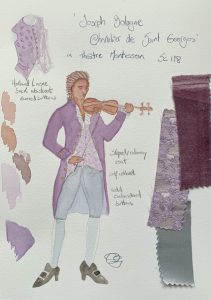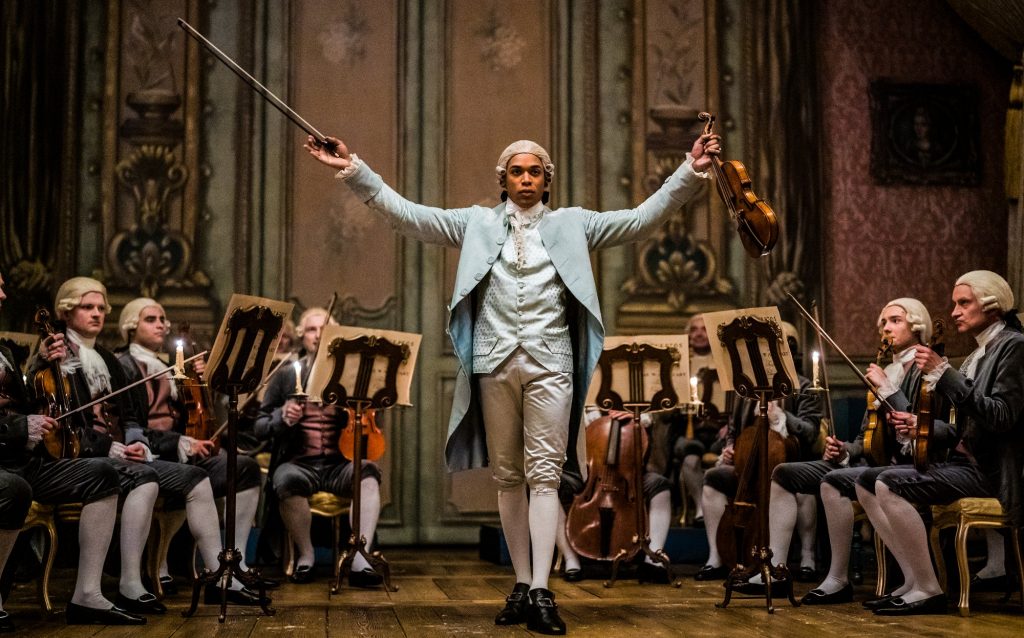
Joseph Bologne, Chevalier de Saint-George—the violinist, conductor, composer, and soldier—made his historical mark in 18th-century France as the first classical composer of African descent to attain worldwide fame in European music. His life story, dramatized in the film Chevalier (Searchlight Pictures), features a staggering array of Victorian styles of the era worn by principles. There’s Chevalier (Kelvin Harrison, Jr.), Marie Antoinette (Lucy Boynton), and Marie-Josephine (Samara Weaving), but with a modern flair courtesy of costume designer Oliver Garcia (Soulmates, England Is Mine).
The Spanish-born Garcia studied art there but quickly realized his “passion for fashion” needed further exploration. Moving to the U.K., he designed costumes for fringe theater and music videos for UK-based bands. Gravitating to the world of film, he was assistant costume designer to costume designer Sandy Powell for The Favourite, Mary Poppins Returns, and Cinderella, as well as assistant costume designer for Anna B. Sheppard for Maleficent.
Making a costume unique with his own signature styling is what has set him apart, catching the attention of Chevalier director Stephen Williams. Williams wanted the costumes to reflect history but still feel familiar with today’s trends. Garcia did just that, poring through the historical fashions of the 18th century in and out of court and ballroom attire, accenting them with a contemporary flowery flourish or with a palette that is reminiscent of a certain purple-inspired rock star.
Below The Line spoke with Oliver Garcia via Zoom video from his home in London, where he discussed his design process, from selecting the pastel color palettes and detailed textures to hand-made finishes and distinctive silhouettes. He discussed designing the head-to-toe creations and how they visually tell the characters’ stories.
Below The Line: I’d like to begin with the historical research that you delved into for this specific period piece. Where’d you start there?
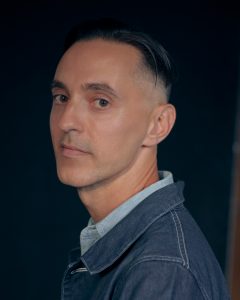 Oliver Garcia: How did I begin to research 300 years ago? (chuckles) My research pretty much starts with the books that I usually have or my library, and then I go on to online sources and museums. Museums always give you the chance to look at existing garments, which for me are the most valuable things to look at because you can feel the weight of the fabric, you can see how the garments were cut, you can see how they were constructed, and you can see a lot of information in your hands that you can’t tell by just simply looking at images.
Oliver Garcia: How did I begin to research 300 years ago? (chuckles) My research pretty much starts with the books that I usually have or my library, and then I go on to online sources and museums. Museums always give you the chance to look at existing garments, which for me are the most valuable things to look at because you can feel the weight of the fabric, you can see how the garments were cut, you can see how they were constructed, and you can see a lot of information in your hands that you can’t tell by just simply looking at images.
I just gathered a load of information, a load of images that are related to the mood of the film and to the characters that we are telling, and then it just gets divided into mood boards for each of them. With that, you communicate with the director and the production designer to create the costumes that you see on screen.
BTL: Can you talk more specifically about those mood boards and the conversations that you had with the director and designing the color palette.
Garcia: When I started the project, Stephen Williams, the director, was very clear from the very beginning that he wanted to do a film that would appeal to contemporary audiences. I mean, costume designers nowadays say that they do just that, but he was very adamant that that was something very important to him. He talked a few times about Prince and Jimi Hendrix as influences for Chevalier, so that was a very big creative challenge.
We came to the conclusion that the best way to recreate 18th-century costume was through the perspective and influence of contemporary fashion. I’m always very influenced by contemporary fashion, and when you look at clothes and design nowadays, it’s pretty monochromatic head to toe. How fashion designers dress today and the surface decorations that they do in clothing, even in haute couture, are not as flamboyant and oversaturated as they were in the 18th century.
So the time and the brief from the director dictated the color palette and how monochromatic it is in each of the characters. It also helps to tell the story when you look at them on the screen and recognize them and their color palette.
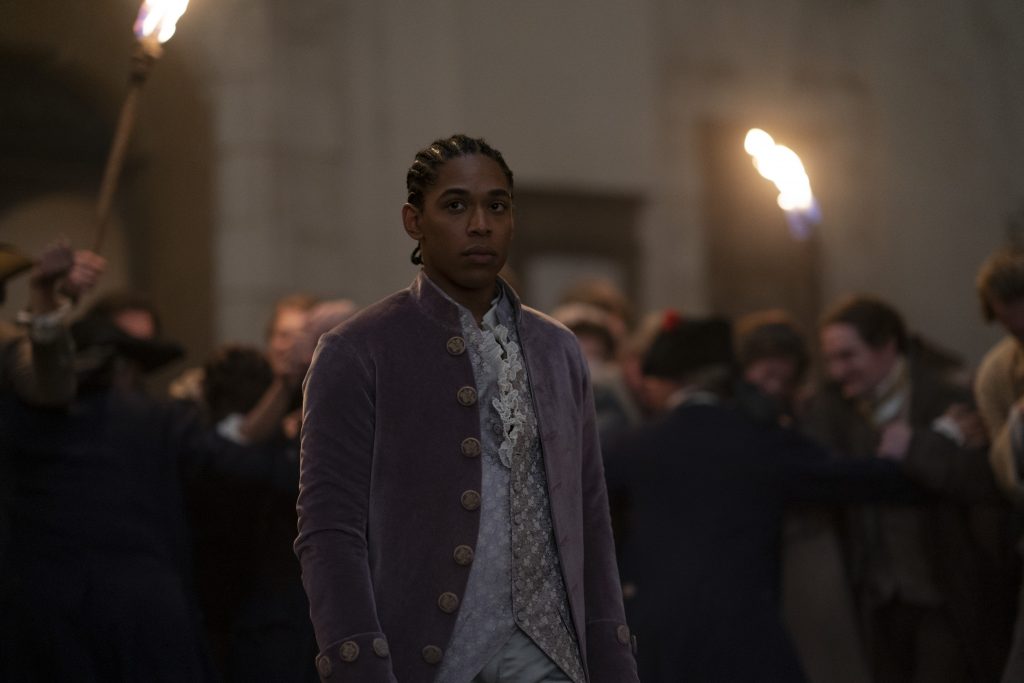
BTL: I love that you looked to Prince. I mean, that is such a big thing because he obviously didn’t dress very contemporarily. He really did look back in time.
Garcia: Yeah. He was mostly an influence in the way that I looked at him for how he dressed, but it was Kelvin Harrison Jr. and Stephen Williams who were influenced by him from his swagger, the way he moved, his presence on stage, and how he challenged the times that he lived in by his artistic expression. So what I took from him mostly, which was dictated by Stephen as well, was the use of one color. It was the purple, which is a color that we associate a lot with Prince, and I just used that at the end of the film when he does his last concert.
BTL: Did any contemporary figures influence Marie Antoinette?
Garcia: I didn’t have anyone in mind for Marie-Antoinette in a specific way. I think for her, it was mostly rooted in the historical research that we did. I avoided looking at how she’s been represented in all the films because she is such an iconic figure that has been on screen in many different films, so I tried to do my own version and be part of the legacy on the screen for her.
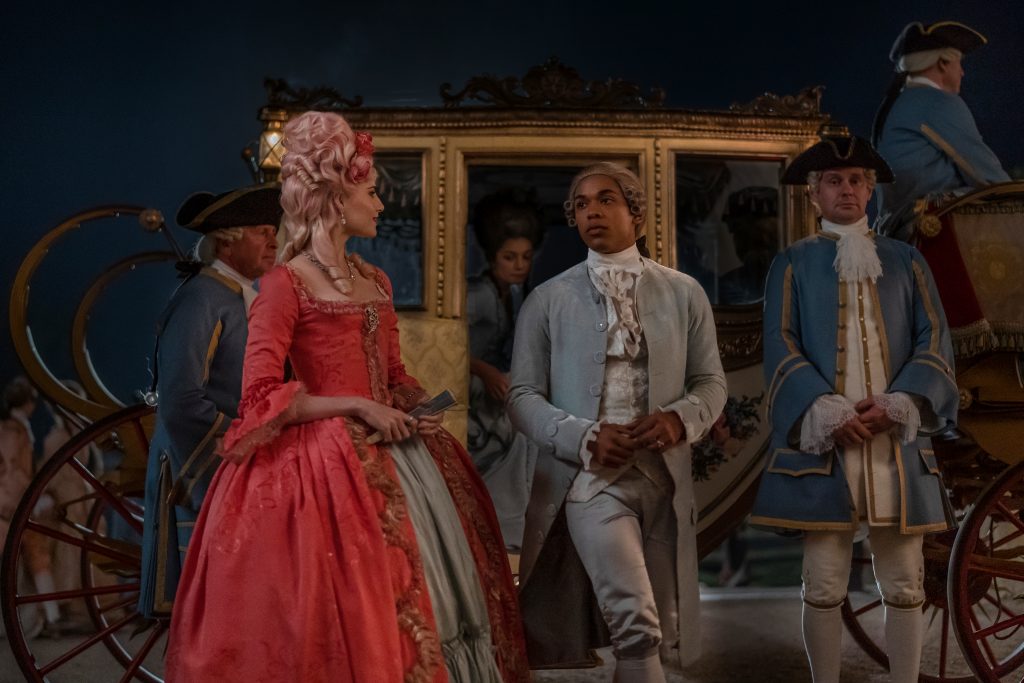
BTL: What was your personal take on her costume?
Garcia: In most of the portraits that we know of her and that I looked at, her costumes were very elaborate. There is a lot of decoration in them, and she changed her silhouette quite a bit. She had changed from tight-fitting garments to a bit more flowing garments. So what I was most consciously doing was trying to reduce the amount of surface decorations that her costume had, and I just selected a few silhouettes that we can easily recognize and attribute to her and just recreate those as accurately as we possibly could.
BTL: Are they wearing the carriage underneath to create that silhouette?
Garcia: Some of the dresses have the panniers and some of the dresses just have the right underpinnings to hold and create the shape, but they are also done in lightweight cottons and then you have the bones that hold the shape which is cotton and a material called rigilene. It’s like boning that you usually use as well in corsetry.
BTL: Did you source your materials? How did you get everything together?
Garcia: That was a challenge because we were filming when COVID restrictions were still on and we were preparing in Prague. There is a lot of skilled craftsmanship in Prague, but unfortunately, there are not many good materials available to purchase. So all my sourcing for materials was done between Italy, the United Kingdom, and France. I was mostly looking for silks. It’s the main material that we were using.
Silks in all forms. There is silk velvet and silk taffeta. There are a lot of very nice and lightweight materials that we used. I do not think there is any heavy material apart from the ones that you see on the Baroque operas that don’t have much screen time, but that’s where perhaps you can say that there are some heavier materials, but all of the costumes from the principles are very, very light materials. The construction inside, as well as all the backing with Holland linens, are all lined with a lighter silk as well.
BTL: What was the most challenging aspect for you?
Garcia: I got the job five weeks in, and literally the minute that we started manufacturing, it was four weeks out, so it was a huge undertaking. We were literally making costumes up until the day before that we’re going on camera, sometimes even at midnight or one o’clock in the morning. It’s not normal that you have such a short prep time, but due to the circumstances of COVID, that’s how it was. But I’m very happy with how it turned out. I think for the time and the resources that we had, it’s a pretty cohesive-looking film.
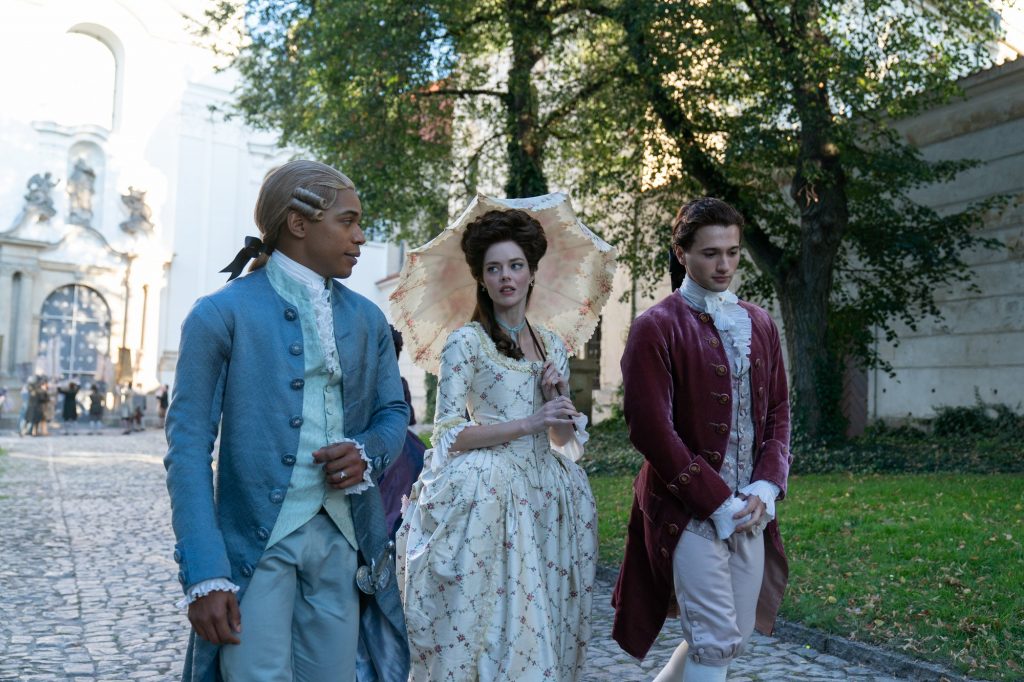
BTL: Let’s talk about the opera dress design for Marie Josephine.
Garcia: That dress had to symbolize the love that both Joseph and Marie Josephine are feeling for each other at the moment. “Opéra l’Ernestine” is the opera that he composes for her, and that costume just truly represents love and is represented by all the cascades of flowers that drop down from her hair all the way down.
They go on to the stage, and they become part of the staging of the opera. It’s very beautiful, in my opinion. The costume, the colors, and the flowers are very eye-catching. It’s a shame it doesn’t have a longer screen time because it’s a stunner. I think it’s the star of the film. For me, it’s the most beautiful of them all and the one that took the longest as well.
BTL: Where would you say your passion for fashion comes from?
Garcia: I remember being very young and being interested in fashion. I grew up when MTV was a very big thing, so I remember watching a lot of music videos, music performances, and a lot of films. My brothers were film fans, so there was a lot of art around my house.
What drew my attention the most was fashion, and that’s what kind of brought me to move to the UK. I started studying it but just rapidly moved on to the performing arts because that’s where I was being offered work and it was a way to make money. Fashion seemed like a long journey before you could actually make a living out of it.
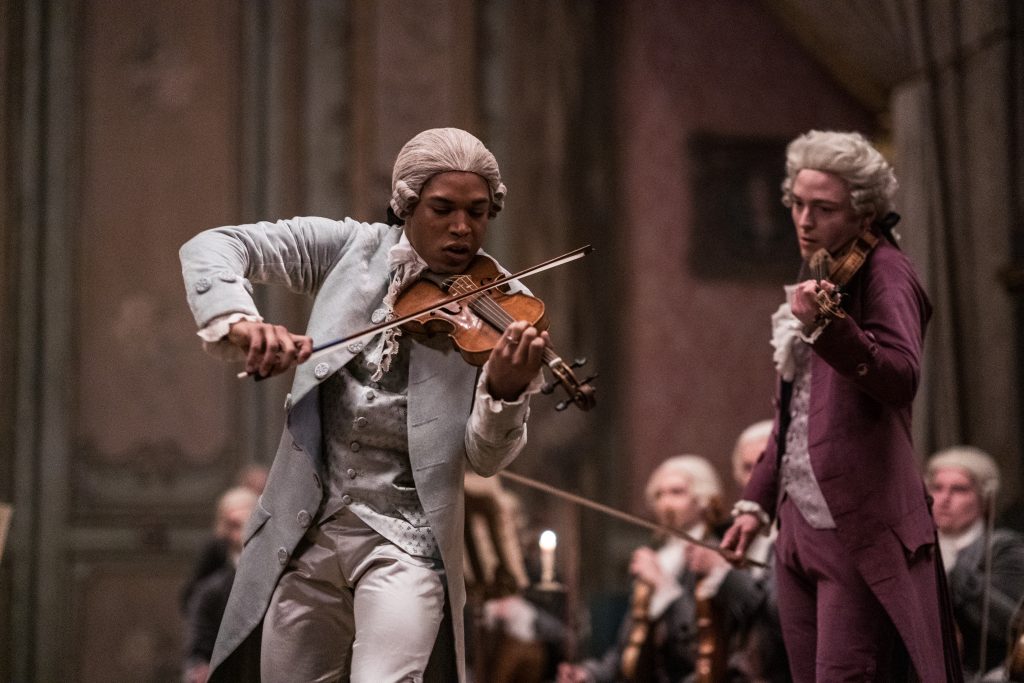
BTL: So, getting back to Chevalier, he had different looks from casual to concert.
Garcia: In terms of the looks of Chevalier, there’s almost two stages to this character that they’re divided into. There is stage one, when he’s in Marie Antoinette’s court, when you can describe him as looking, searching for social acceptance, and the clothes that he wears there are coded in mostly pale blues and blue colors. He has day wear, evening wear, and court wear, so it is a rotation of different jackets and different waistcoats that he wears according to the occasions that he finds himself on.
Then we have the second part of the film, when he realizes that self-acceptance is a little bit more important than social acceptance, and that’s when he’s more into green and gold colors that are more in tune with his African roots. He does have his pleated ruffles both on the cuffs and both around the neck, which is something that I creatively decided to do was to remove the use of lace.
At this time, men’s costumes would have lace coming out of the cuffs and cascading from the necks, but it was a creative choice to substitute that for something that felt a little bit more contemporary. I used very fine cotton, pleated it, and used it in the same place where lace would have been.
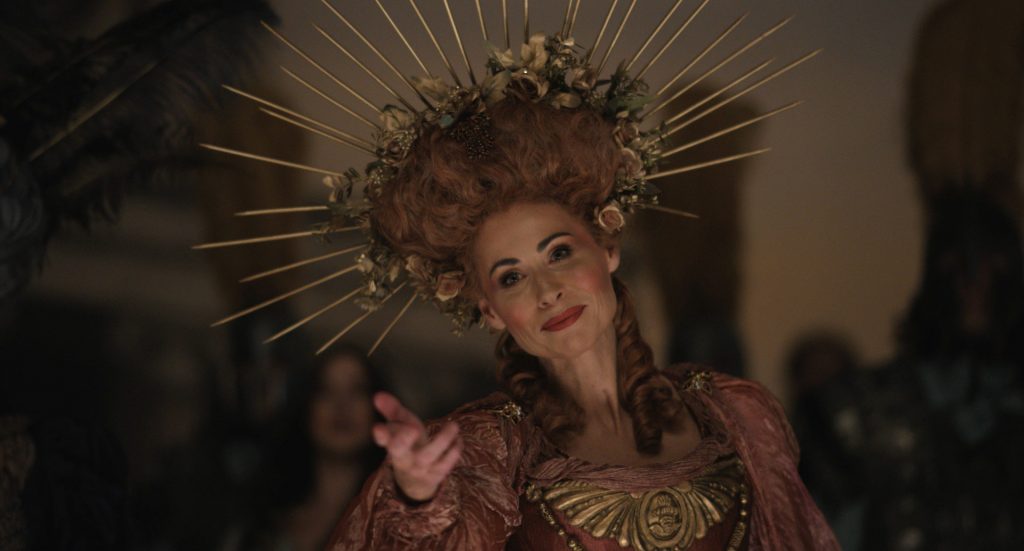
BTL: There’s an amazing head piece that is worn by La Guimard played by Minnie Driver. How did you liase with that department?
Garcia: The head pieces are actually from the hair department. We collaborated on what materials would go there because we try to match head-to-toe and combine everything together. But the actual design of the headpieces was done by Francesco Pegoretti, who is very talented and did all the wigs for all the characters. I mean, the collaboration with Francesco and pretty much with everyone else on the team was a very easy connection.
I think we all gelled, we all got along very well together, and we creatively spoke the same language. When you connect with someone and have to say very few words in order to create an image or a look, it is really as simple as that. We all had the same references that we were all looking at, and we all had the same instincts, so it just became quite a joy for everyone involved.
BTL: What sbout the lower echelon characters, who were not necessarily of the court.
Garcia: In the 18th century, the shape of clothing didn’t really change much. It’s mostly the decoration and the type of fabric that you would have used. I made a distinction between social classes by using color.
If you were a very lower class, then your clothes would be more towards the browns and the beiges, and your clothes would not have been made of materials that would be as shiny or light-reflecting as the ones that you see in aristocracy.
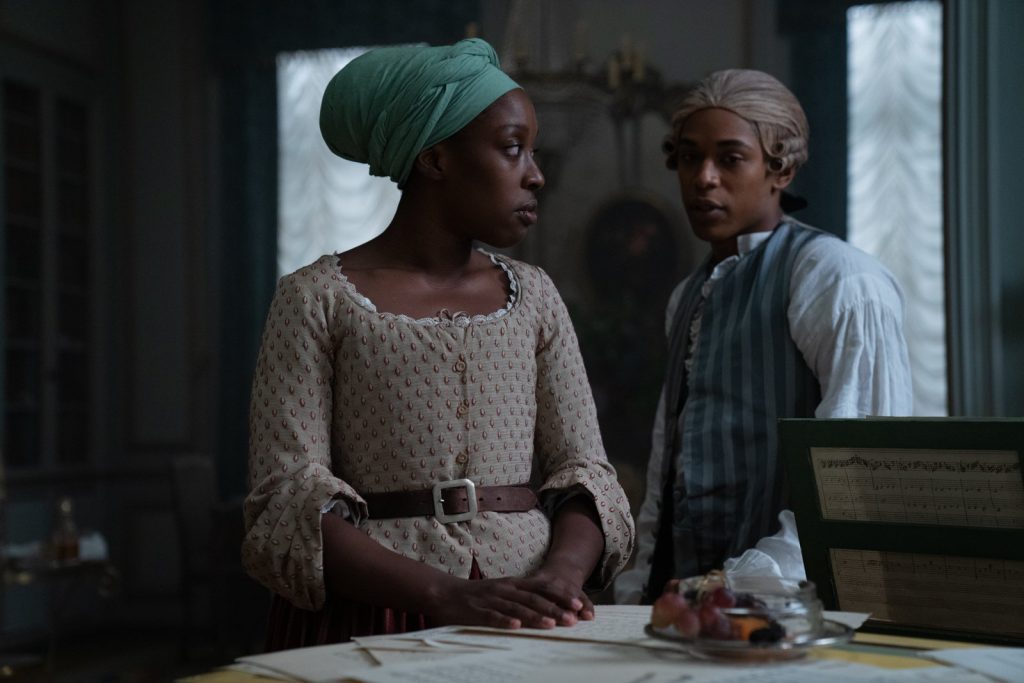
BTL: For instance, Nanon’s looks which appear to have had a whole different color palette.
Garcia: She’s an interesting one because she has a different color palette. She’s the character that arrives in France for the very first time. I wanted to show that she struggled with adopting or conforming to the clothes of the time, so I kept her in colors that would easily associate with her background, and slowly I introduced her to the silhouette of the period, but again, removing a lot of the lace that would be recognized as 18th-century fashion. Slowly and gradually she gets into it, and the final costume that she wears at the last concert is the one where it is fully 18th century, the fabric is reflected silk, and it’s the most luxurious that she’s been seen in.
BTL: So aside from your favorite opera dress, what else are you most proud of?
Garcia: Overall, it’s the color palette. I’m really pleased with how it feels fresh to look at the 18th century. I’m proud as well to have been brave enough to do my own interpretation of the period rather than try to make every single costume that I saw in a reference.
I respected the silhouette, but then I interpreted it in the colors that I thought were appropriate for the mood of the film, and I decorated or did not decorate them in a way that was best for the film and for the characters. So, I’m very proud of that. Everyone was so involved in it and so passionate about what we were doing. It was a joy to do this film.
Chevalier is now available to stream on Hulu.

